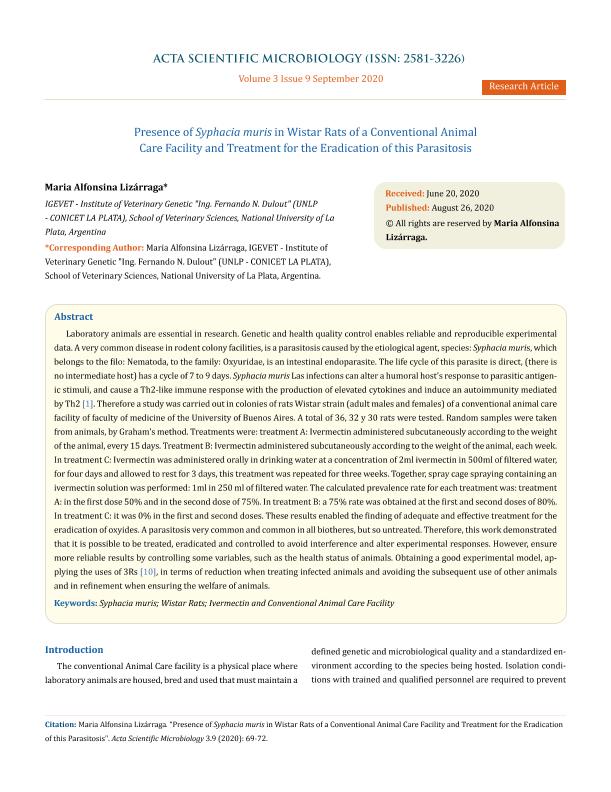Mostrar el registro sencillo del ítem
dc.contributor.author
Lizarraga, Maria Alfonsina

dc.date.available
2022-05-24T02:58:24Z
dc.date.issued
2020-08
dc.identifier.citation
Lizarraga, Maria Alfonsina; Presence of Syphacia muris in Wistar Rats of a Conventional Animal Care Facility and Treatment for the Eradication of this Parasitosis; Acta Scientific Microbiology; Acta Scientific Microbiology; 3; 9; 8-2020; 69-72
dc.identifier.issn
2581-3226
dc.identifier.uri
http://hdl.handle.net/11336/158092
dc.description.abstract
Laboratory animals are essential in research. Genetic and health quality control enables reliable and reproducible experimentaldata. A very common disease in rodent colony facilities, is a parasitosis caused by the etiological agent, species: Syphacia muris, whichbelongs to the filo: Nematoda, to the family: Oxyuridae, is an intestinal endoparasite. The life cycle of this parasite is direct, (there isno intermediate host) has a cycle of 7 to 9 days. Syphacia muris Las infections can alter a humoral host´s response to parasitic antigenic stimuli, and cause a Th2-like immune response with the production of elevated cytokines and induce an autoimmunity mediatedby Th2 [1]. Therefore a study was carried out in colonies of rats Wistar strain (adult males and females) of a conventional animal carefacility of faculty of medicine of the University of Buenos Aires. A total of 36, 32 y 30 rats were tested. Random samples were takenfrom animals, by Graham´s method. Treatments were: treatment A: Ivermectin administered subcutaneously according to the weightof the animal, every 15 days. Treatment B: Ivermectin administered subcutaneously according to the weight of the animal, each week.In treatment C: Ivermectin was administered orally in drinking water at a concentration of 2ml ivermectin in 500ml of filtered water,for four days and allowed to rest for 3 days, this treatment was repeated for three weeks. Together, spray cage spraying containing anivermectin solution was performed: 1ml in 250 ml of filtered water. The calculated prevalence rate for each treatment was: treatmentA: in the first dose 50% and in the second dose of 75%. In treatment B: a 75% rate was obtained at the first and second doses of 80%.In treatment C: it was 0% in the first and second doses. These results enabled the finding of adequate and effective treatment for theeradication of oxyides. A parasitosis very common and common in all biotheres, but so untreated. Therefore, this work demonstratedthat it is possible to be treated, eradicated and controlled to avoid interference and alter experimental responses. However, ensuremore reliable results by controlling some variables, such as the health status of animals. Obtaining a good experimental model, applying the uses of 3Rs [10], in terms of reduction when treating infected animals and avoiding the subsequent use of other animalsand in refinement when ensuring the welfare of animals.
dc.format
application/pdf
dc.language.iso
eng
dc.publisher
Acta Scientific Microbiology
dc.rights
info:eu-repo/semantics/openAccess
dc.rights.uri
https://creativecommons.org/licenses/by-nc-sa/2.5/ar/
dc.subject
SYPHACIA MURIS
dc.subject
WISTAR RATS
dc.subject
IVERMECTIN
dc.subject
CONVENTIONAL ANIMAL CARE FACILITY
dc.subject.classification
Otros Tópicos Biológicos

dc.subject.classification
Ciencias Biológicas

dc.subject.classification
CIENCIAS NATURALES Y EXACTAS

dc.title
Presence of Syphacia muris in Wistar Rats of a Conventional Animal Care Facility and Treatment for the Eradication of this Parasitosis
dc.type
info:eu-repo/semantics/article
dc.type
info:ar-repo/semantics/artículo
dc.type
info:eu-repo/semantics/publishedVersion
dc.date.updated
2022-05-06T15:40:35Z
dc.journal.volume
3
dc.journal.number
9
dc.journal.pagination
69-72
dc.journal.pais
India

dc.description.fil
Fil: Lizarraga, Maria Alfonsina. Consejo Nacional de Investigaciones Científicas y Técnicas. Centro Científico Tecnológico CONICET- La Plata. Instituto de Genética Veterinaria "Ing. Fernando Noel Dulout". Universidad Nacional de La Plata. Facultad de Ciencias Veterinarias. Instituto de Genética Veterinaria; Argentina
dc.journal.title
Acta Scientific Microbiology
dc.relation.alternativeid
info:eu-repo/semantics/altIdentifier/url/http://actascientific.com/ASMI/pdf/ASMI-03-0679.pdf
dc.relation.alternativeid
info:eu-repo/semantics/altIdentifier/doi/http://dx.doi.org/10.31080/ASMI.2020.03.0679
Archivos asociados
